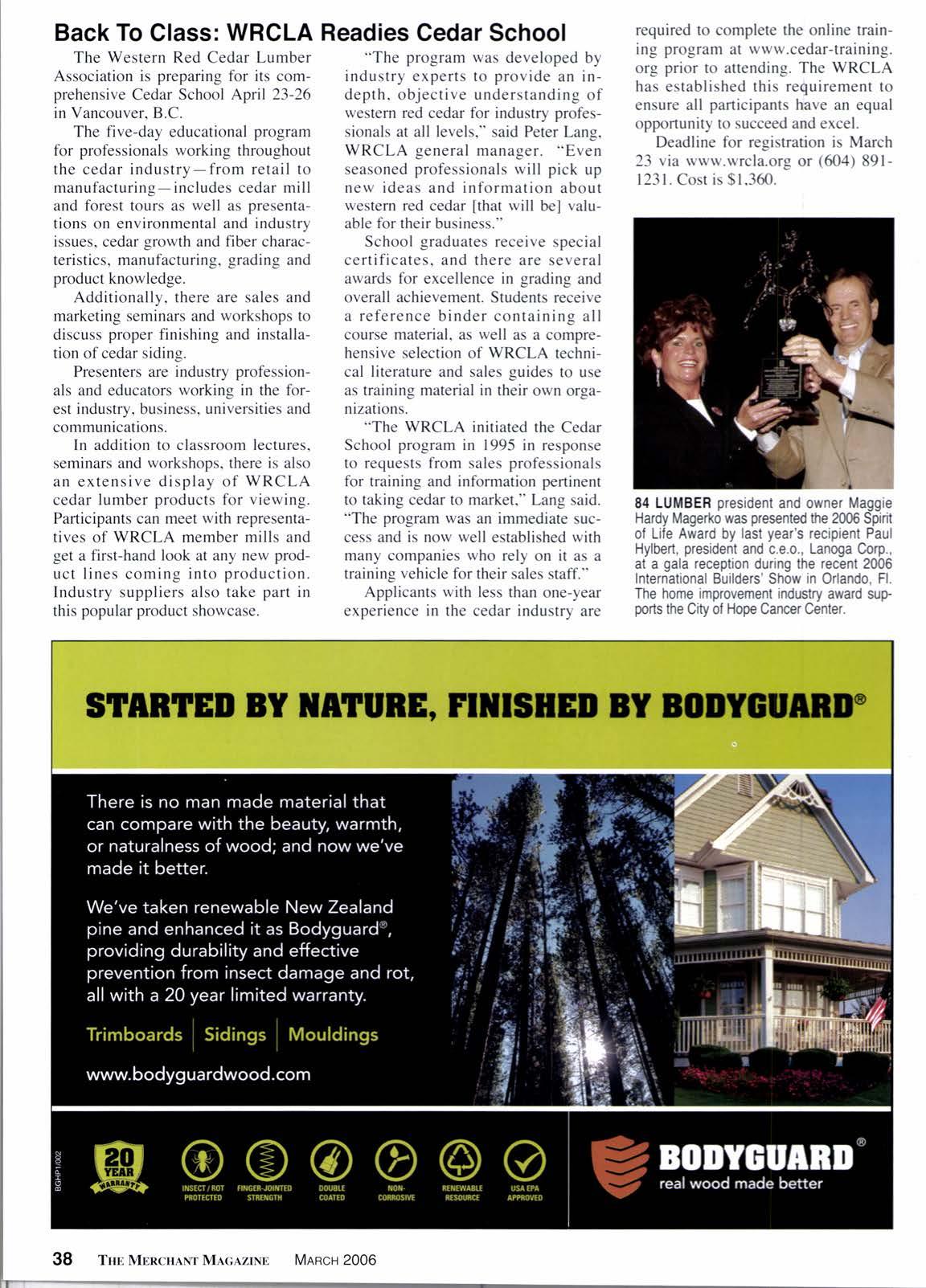
4 minute read
Pnlco Selling Doug Fir Tract
Unable to cut enough timber to make payments on $700 million of financing, Pacific Lumber Co., Scotia. Ca.. lvants to sell 60.000 acres of mostly ranchland and Douglas fir forests.
"We do not want to sell off our core redrvood lands," said spokesperson Chuck Center. "They're the lifeblood of our company."
Pnlco president Robert Manne assured employees that "rve are not liquidating the company or its timberlands. This is not a massive sell-off. but rather part of our larger restructuring efforts."
"lt's kind of a procrastination strategy," said Matt Wirz, an editor at Debtwire. a distressed bond nervs service. "There's no doubt in anyone's mind that the company has to restructure itself. They can't cut enough trees to fund the bonds."
Founded more than 140 years ago, Palco rvas purchased in 1986 by financier Charles Hurrvitz. The company's redrvoods-the largest privately olvned groves of old trees-have been the focus of countless legal battles rvith regulators and environmen- talists. PnI-co maintains that the millions spent on these battles-plus the resulting regulationshave depleted the company and caused mill closures and layoffs.
Meanrvhile. the company plans to finish planting 700.000 redrvood seedlings. "All this is part of Pelco's commitment to sustainable forestry practices." said Gregg Bratcher. regeneration forester for the company.
"ln order to be certified or recertified. rve have to do certain things." said Chris Manson. Pelco's manager of regional government relations. "One of these things is to make sure we are planting seedlings for trees that rve harvest."
The plantings are an annual event that cost the company an estimated $ I million. "All of PeLco's 220.000 acres are subject to some of the strictest environmental standards in the rvorld." said Bratcher. rvho noted that the company voluntarily plants more than required by state larv: five trees for every one cut.
Alaska Mill Back For Now
Just trvo months after shuttine dorvn. Pacific tng & Lumber is back in business on Gravina Island, Ak.
According to owner Steve Seley, the mill closed because he was tired of rvorking rvith the U.S. Forest Service. rvhich manages the l7 million acres of the Tongass National Forest (see Feb., p. 48). Norv that the federal agency has stepped up efforts to make more timber available. Seley called workers back to the mill. Pacific is one of the ferv remaining milling operations left in the forests of southeast Alaska.
The future of the mill rides on the a-sency's Buckdance-Madder timber sale. for which Seley is the apparent high bidder. He also has a contract for another l6 million bd. ft. from other sales.
New Uses For Oregon Biomass
Clearing a backlog of biomass from Oregon's forests could prevent fires and produce electricity. according to the Oregon Business Council.
"Here in Oregon, rve have a unique asset in the form of millions of acres of timberland in need of thinning." said Allyn Ford. president and c.e.o. of Roseburg Forest Products. who heads the council's efforts to encourage rvood-products manufacturers to use the waste to fuel onsite powergenerating facilities. Any excess energy rvould be sold to public utilities.
"When the cost of oil goes over $50 a barrel. all of a sudden a lot of things click into place." said Ford. By next spring. Roseburg rvill open its own porver facility at its plant in Weed. Ca.
Along rvith other industry officials, Ford spoke before a house committee in support of clearing forests for biomass. Much of the timber "is stunted like carrots in a patch that didn't get thinned." said Ford. resulting in dan_eerously overgrown forests and timber that isn't suitable for lumber.
"We have a huge volume of biomass that has been building over the years." said Russ Hoeflich, Oregon director for The Nature Convervancy. "A srveep of fire is normal," he said. "But norv we are out of balance and prone to unnaturally severe wildfires and disease."
An estimated l5 million acres of Oregon forest needs clearing, most of it orvned by the U.S. Forest Service. Cut at an annual rate of 7(X),000 acres, biomass could make 20% of the electricity used in Oregon each year-for the next 20 to 25 vean.

Back To Class: WRCLA
'[-h.' \\ c:tclrr I{ctl ( ctllrl Lrrrrlre r'
.\::ocilttiotl is Ir'c11;11i11" lol il. eotll plchcn'irc ( ctllLr.Sehr,i,l \pr il l.l l{r irr VaneoLrr cr. ll.(
'[-hc l ir c rllr,r cLlue lrtionll plr,.LlrLrn lirr prtrlcr.rOnll\ \\ ()r'kirlr tltr'()Lr-!]t()ut tlrc cctllu-rntlLr:trr llorr rctlril 1,, nuutLtllretLtrinl ineltttlc. ecrlrrr nrill lttttl lir|c:t t()Llr\ l\ rirll ri. l)l('\alltii liolts on clr\ ir'()nllcntlrl lnrl intlrr.trr i.sLtcr. tctlltl gr.olrth irnrl lilrct r'hlltlrt' tclisties. ntlrnLrllietrrlinr. -Lllitlin-L lLn,l proclLre t knorr Icrl lc.
.-\tltlitiLrnlrllr. tlrclc r.irc rlrlcr lrntl rnill'kctinc :crninlrr'r llnrl \\ (Jlk\]rr)|\ l() rli:err.r ltf()l)rf firrislrirr,' lrntl in.tlrlllrtiott ol ec-tlltt 'irlirtr.
I'rr'.e1lt'r'. lrr'. irr,l t\lr\ l\t,'li..r, r als lLrtrl crlLrr'lrtor'. \iot kinl in lhe li,r' c-st ittcltt:tlr. lr11:i11q'ss. ttttir ct''itie. lLttrl c()lillllLllt t! irl t()115.
IIt ltltlititrn Io tlrrssloont lc.lLrt.'r. scrttiniu: iulrl \\()lf.\hr)|5. 1l1g'1!' j: ;115qr lul c\tcn\irc tl irplrr,r ol \\ Ii( I..\ uctllt| ]ttnrlrct' Itotlttilr l()f \ iL'\\ r1l)rrrticiprrnt: ci.ul nlcct rr itlr tcIr'c.e ntlr tircs ol \\ R('l \ nrcrrhrl rttill' urtrl !.ct ri lir':t llrntl lrrLrk ilt iut\ na\\ l)11)(l uct lillc\ c()lilinS inl() lr'()rlLl!li(rn.
IntlLt.ltr :Lrltltlitr': lLlsrt trtkr' l)iil't rl this popLrilil l)l)rltre t \lr()\\ f iL\c.
Readies Cedar School

'' l Itc 1,1,,"1 1t11 \\il\ 11.",.']i,|..1 1.1 in.iLr'lt.t !'\lr!t.l\ l\r l)i(r\ lrla illt tn rltl'1] '''1"'l' ' l'l-1'l
\\!'\l!'rr r,il r'.tllrr l,,r in,lLr.lr) [)r,)1.'
\i()nirl\ lLt lLll lir,l.. .lr.l I'.'te r I.trnl.
\\ lt( I \ .L. rtclrl nri.Lnir:! r . i.r ,'n rla\\ l!l!'ilr itllrl rll\\l lll.il1,,11 .11r1r111
:g';1:rrllfql 1111r1..r.j1r11.11, l ilJ It.L 111.
\\ t':lt'l tt t t'tl r'atllrt ] lltlLt tr r I I 1.. ,, ., .i
.,1'1. t.'r tlr,tt r'.. ..-'
Lrr g1 ;11I iL! lria\ .'nrinl il lalaran!c lrllt(lal
!(\ul.\(' lllitlal llt]. lt.
]tctlrir.' :q']11{11r11 irl
I lrr \\ Ii( l \ initrrrtcti llre ( i.l.rr
\.1 ,',' l' r'.rtri r. ."": ..r" lrl lr'(]LlC\l\ ll()lll \ii]a. 111q'1...11r11.1]. li,t ti lrinin-r irrrrl inlljl ntirll(rlt lra|titlinl
Irt tltkttl-L !r'(iiLI l\r ttt.rt kil. ] .rttr ..rt.l r't,.' lLntl i. 111rr,, ',i.'ll i.ttLl.lirlti.i ri itlt lllitll\ !(\llll)lltliC. rr llr, It'lr r,tl :l .r- .r tlirittitt! r iltiil.' I,,r'tltcr ..rle' .llrll \1r|11.11111. \\ ttlt li.. lll.rn r)ll- \.irt er|r'1 i.'11.a irt l]ti .i.i.rr' rtrlLl'tr \ .Lr'.'
"'l ll.' 1,1,,1111111 \\ il\ itll illllllarliiil.' .it.











